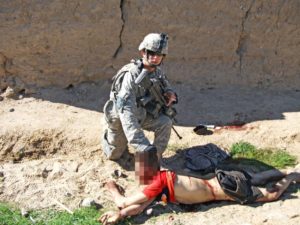One of the arguments that interventionists, including many U.S. military veterans, use to rationalize the U.S. defeat in Afghanistan is that U.S. forces were fighting to bring “freedom, democracy, and women’s rights” to the country. In fact, the Pentagon even coined the term “Operation Enduring Freedom” as one of the ways to justify the invasion and occupation of the country. Even though the effort failed, the argument goes, interventionists, including veterans, should nonetheless feel good about their “service” to both America and Afghanistan.
There is a problem with this rationale and justification, however. The problem is that it is evil to the core.
In any invasion and occupation, there are inevitably going to be people killed, injured, and maimed. There is also going to be destruction of homes, business, and infrastructure. That certainly proved to be the case in Afghanistan.
Therefore, what interventionists were — and are — saying is that all those deaths, injuries, and property destruction were worth bringing freedom, democracy, and women’s rights to Afghanistan.
But who died and made these people the arbiters of that type of mathematical life-and-death calculation? After all, those who were killed in the process would never have experienced freedom, democracy, and women’s rights. That’s because they would be dead.
Now, it’s one thing for the citizens of a country to decide for themselves whether to revolt against the tyranny of their own government. Violent revolutions can be very costly in terms of life and property. That’s why people might decide to put up with a lot of tyranny before they revolt. They don’t want to lose their family members, friends, and countrymen by revolting, until the situation gets so bad that they feel that they have no choice but to do so. In the final analysis, the decision to revolt and when to revolt can be highly subjective.
But that’s a far cry from U.S. officials making that decision from afar. Their decision is a cavalier one because they don’t put the same value on Afghan life that the Afghan people do. In fact, interventionists put little or no value on Afghan life. That mindset is reflected by the fact that early in the invasion and occupation, the Pentagon, with the full support of Washington, D.C., officials, made the conscious decision to not even keep track of how many Afghans they were killing. Moreover, there was never an upward limit on the number of Afghan people who could be killed, injured or maimed in the effort to bring freedom, democracy, and women’s rights to the country. It just didn’t matter. Any number of Afghan people killed in the effort would be considered worth it by U.S. interventionists.
That’s why the purported concern that U.S. interventionists, including many U.S. military veterans, express for the Afghan people rings hollow, given that they were willing to kill or maim any number of Afghans to reach their political goal.
How many Afghan lives were worth the U.S. effort to bring “freedom, democracy, and women’s rights” to Afghanistan? None! It was never morally or religiously justified for the U.S. government to kill even one single Afghan citizen for the sake of a political goal. Killing, injuring, or maiming even just one single Afghan, much less hundreds of thousands of Afghans, for the sake of “freedom, democracy, and women’s rights” has always been the epitome of evil.


